Armoured mud balls as a result of ephemeral fluvial flood in a humid climate: Modern example from Guizhou Province, South China
Gerhard H. Bachmann
Martin-Luther-Universität Halle-Wittenberg, Institut für Geowissenschaften, Von-Seckendorff-Platz 3, D-06120 Halle (Saale),Germany
Abstract Armoured mud balls were observed after rainfall and a short flood in the otherwise dry Xiaohe (small river) valley of Guanling County, Guizhou Province, South China, approximately 30 km southwest of Guanling City. Armoured mud balls are most common in semiarid climates, but rather unusual in a humid climate as in Guizhou. A number of well-rounded mud balls, 2-20 cm in diameter, were found lying on the gravel of the Xiaohe gully floor. The mud balls consist of sticky, light brown and slightly mottled clay without carbonate content. The surfaces of the mud balls were studded with rims of sand- or gravel-size limestone clasts, collected during bedload transport, as is typical for armoured mud balls. The mud balls originated from alluvial mudstone deposits of the valley floor and cliff that are most likely derived from the weathering and karstification of bedrock limestones. Such mudstones with high clay content seem to be especially well suited for forming armoured mud balls. As flood events are rather common in the area, the formation of armoured mud balls should be very frequent in the Xiaohe valley and similar valleys nearby, giving the possibility for further and more detailed studies. To the best of our knowledge this is the first description of armoured mud balls in China.
Key words armoured mud balls, fluvial, alluvial, mudstones, humid climate, Guizhou,South China
1 lntroduction *
Alluvial mudstones are often surprisingly resistant to erosion, despite their unlithified and often semiconsolidated character. Such is especially true for mudstones with a high clay content because of their high cohesion.They are most frequently eroded as smaller or larger mud chips following desiccation and mud cracking. Other sites of erosion are the undercut banks of streams and rivers,where alluvial mudstones may form steep cliffs. Erosion is enhanced, especially during flood events, by undercutting, slope failure, and subsequent slumping of the cliffs.Small and large blocks of semiconsolidated material may then fall into the turbulent water, where they are rapidly softened and washed away. In some cases, however, mudstone fragments can become embedded in silt or sand and so preserved.
Rather unusual, however, are small or large, mostly well-rounded mud balls that are transported like gravel or boulders over considerable distances. The term “armoured mud balls” was introduced by Bell (1940) for spherical clay masses studded with pebbles. Examples are known from the recent and fossil record (e. g. Matheret al., 2008).Pettijohn and Potter (1964) defined armoured mud balls (or“pudding balls”) as “subspherical balls of mud, 5-30 cm in diameter coated with coarse sand and fine gravel (Bell,1940)”. They mention how the term translates in other languages: German: “Gespickte Tongerölle”, French: “boules d’argile (balles argileuses) cuirasées / armées”, and Spanish: “rodados de arcilla acorazados”.
This paper describes armoured mud balls observed after a short flood in the Xiaohe creek (small river) of Guanling County, Guizhou Province, South China (Figure 1) and so adds to the scanty literature on armoured mud balls and also discusses their generation by intermittent (ephemeral) high-energy events such as fluvial floods in a humid climate. To the best of our knowledge this is the first description of armoured mud balls in China (Feng, 2012).To the best of our knowledge this is the first description of armoured mud balls in China.
2 Geographical setting
Guizhou Province in southeastern China has a subtropical humid monsoonal climate. The average annual rainfall is approximately 900-1,500 mm; the rainy season lasts from April to September with a maximum in June(http://www.worldweatheronline.com/Guizhou-weatheraverages). The average temperatures are 10-26°C in the night and 18-34°C during the day. Large parts of Guizhou Province consist of mountainous areas that are predominantly formed by thick limestones of Permian and Triassic ages. The carbonates are often karstified and frequently show kegelkarst (cockpit karst) topography with typical conical peaks. The highest peaks rise to more than 1500 m above sea level. Reddish residual karst-derived clayey soils are widespread in the limestone areas.
Guizhou Province has serious environmental problems,such as persistent water shortages culminating from time to time in severe droughts, but also catastrophic floods.These problems are at least partly due to the widespread deforestation of the karstified mountains (Mann, 2011; see also Figure 2). As a result, the soil was rapidly eroded during rainfalls and quickly washed down with the runoff water into ravines and valleys. Part of the downwashed soil,however, was accumulated again in the valley floors forming up to several meters thick alluvial mud deposits (Figure 3). Guizhou was once the poorest province in China and is now experiencing rapid development.
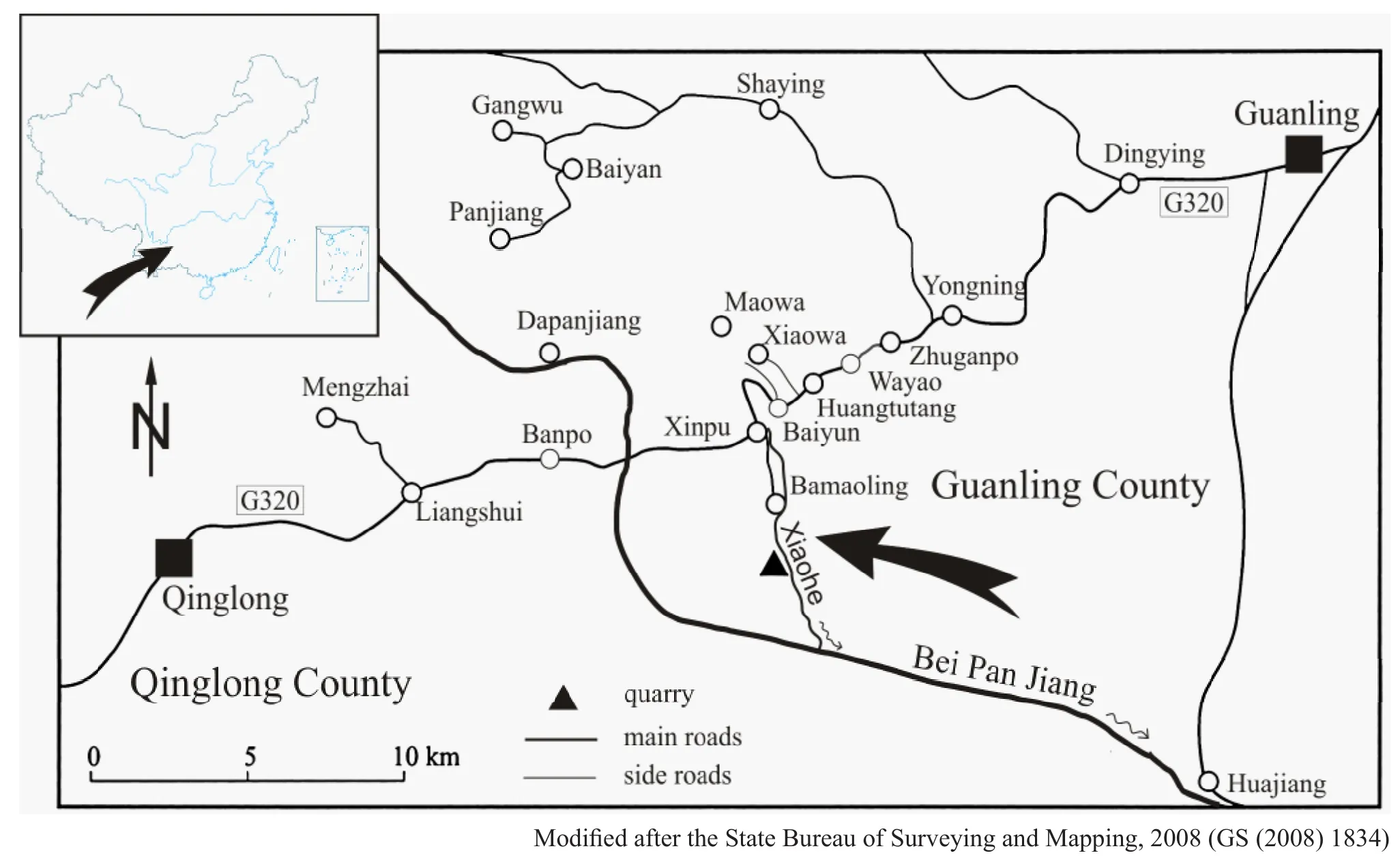
Figure 1 Location of Bamaoling village and Xiaohe (small river) in Guanling County, Guizhou Province, South China. Arrow: Sampling site of armoured mud balls.
The main river of Guanling County is the Beipan Jiang, a tributary to the Hongshui He (Figure 1). Many side-valleys of the Beipan Jiang are dry during most of the year, even after rain, mainly because of the deforestation and karstification. Such is also true for the Xiaohe (small river) that runs approximately north-south to the Beipan Jiang (Figure 1). The upper part of Xiaohe’s small catchment area is near Xinpu, a village at Highway G320 just south of the Guanling Fossil Group National Geopark(Wanget al.,2008) at an altitude of some 1000 m above sea level. Two kilometers downstream, near Bamaoling village (25° 51’02 N, 105° 25’24 E), a small village of the Miao minority, the Xiaohe is approximately 820 m high and is entrenched in upper Triassic limestones of the Zhugangpo and Xiaowa Formations (Wanget al.,2006). The limestones are well bedded and frequently crop out at the slopes. Parts of the slopes are covered with grass, shrubs and small trees. Flat areas have been terraced and are used for agriculture, mainly to grow corn.
To the south of Bamaoling village, the valley floor is up to a few 100 m wide where it is covered with up to several meters of alluvial mudstones and is used for agriculture as well (Figures 2 ff.). The mudstones are derived from down-washed soil. They are light to medium brown, frequently mottled, and have some silt or sand fraction. Rooting and rootlets are common. The river cuts into the mudstones and, partly, into the underlying limestones, forming an approximately 5-10 m wide and up to 5 m deep gully with steep flanks and gentle meanders. The gully floor is covered with banks of more or less unsorted, unrounded to well-rounded limestone sand, gravel and blocks of different size (Figures 2, ff.). Some blocks are more than 1 m in diameter.
3 Armoured mud balls
August of 2002 was very rainy in most of China, causing streams and rivers to rise. In the afternoon of August 17, 2002, the usually dry Xiaohe carried some 1-1.5 m of muddy water that rushed downvalley to the Beipan Jiang.On August 18, when the rain had stopped overnight, the water dropped rapidly. On August 19, the creek was almost dry again with only a few water pools left (Figures 3, 4) and there was easy walking on the gully floor from Bamaoling village downstream for a distance of approximately 2 km and a difference in altitude of approximately 40 m to a location called Bamaoling quarry that is known for its Triassic crinoid and vertebrate fauna (Wanget al.,2006). Rain started again the following night and during the day of August 20 causing the Xiaohe to flow muddy water again. Such activity underlines that even relatively short and moderate rainfalls may rapidly cause water flow for some time in the otherwise dry valley due to rapid runoff in the catchment area. As told by local people similar floods are not uncommon for the Xiaohe and may be up to 2 m high.
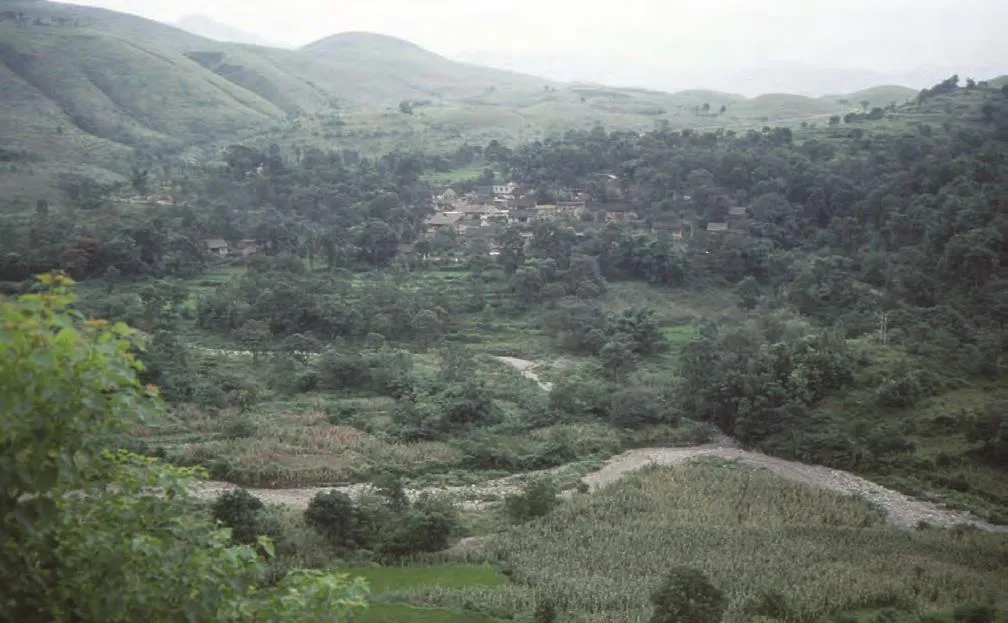
Figure 2 Xiaohe valley with Bamaoling village. Predominantly corn fields on the valley floor, deforested carbonate hills in the background. Haziness is due to the high humidity.
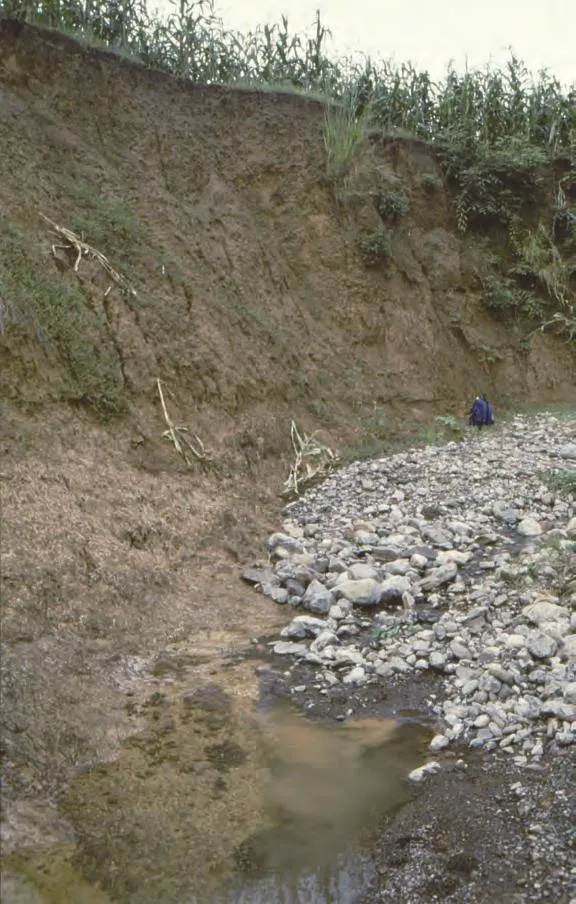
Figure 3 Undercut bank of Xiaohe with cliff in alluvial mudstones. Alluvial gravel and a few poorly preserved mud balls at edge of pool. Rucksack is 0.5 m high.
Armoured mud balls were found lying on the gravels of the gully floor (Figures 4-10). They were well rounded,forming almost perfect spheres, with diameters from 2 cm to 20 cm. The total number observed was relatively small,only a few dozens. Their distribution was rather irregular,some occurred single, others in small groups.
The main constituent of the balls was clay of light to medium brown colour, with slight mottling. The clay was soft and sticky, so that the balls could be squeezed, cut or broken easily. The clay itself was rather smooth (“fat”),with only little silt and or sand; carbonate was absent, as indicated by negative HCl tests. Remarkably, the mud balls were studded with a rim of sand- or gravel-size clasts sticking onto the surface as is typical for armoured mud balls (Figures 5-10). The clasts consisted of the usual limestone sand and gravel found elsewhere on the gully floor. On the larger mud balls the gravel fragments were found up to 1.5 cm in diameter. The roundness of the clasts was irregular on all mud balls, from unrounded to wellrounded. Thin rootlets were found incorporated into some mud balls.

Figure 4 Floor of Xiaohe with gravel banks and a small cliff cut into alluvial mudstones. Some large armoured mud balls (arrows) on the gravel. Corn fields are on valley floor and lower parts of the slope. Triassic limestones outcropping on slope.
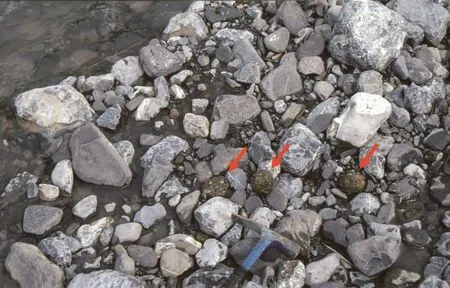
Figure 5 Carbonate gravel and armoured mud balls (arrows). Hammer head is 12 cm in length.
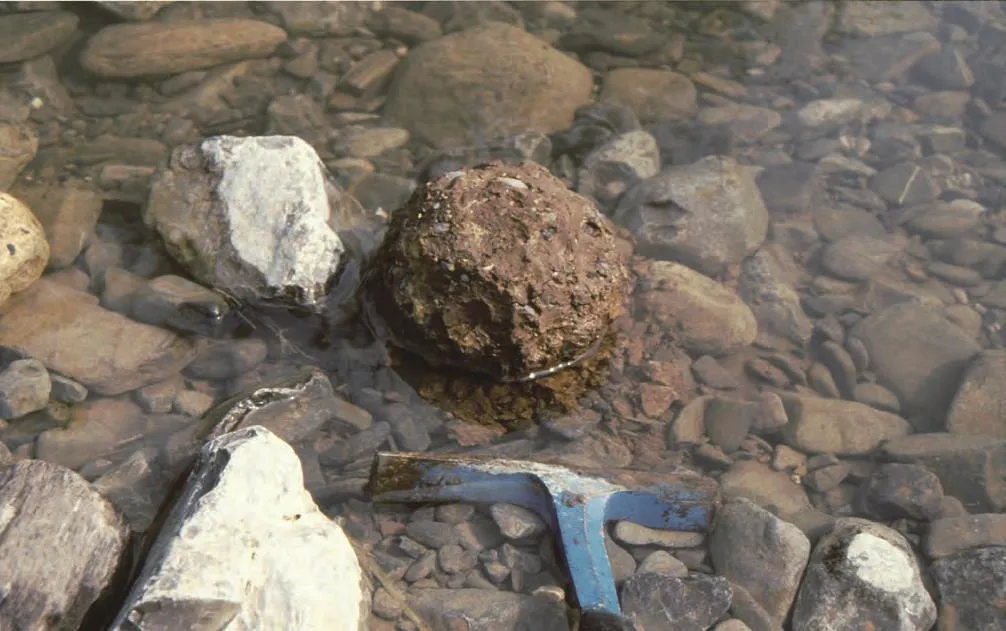
Figure 6 Firm armoured mud ball in water. Hammer head is 12 cm in length.
In the warm air or in the sun, the mud balls became dry rapidly and hard, whereby small shrinkage fractures could develop (Figure 10). Mud balls lying on the gravel or sand,or embedded, kept their shape; others, lying in the water,softened and started crumbling (Figure 7).
4 Origin
Although the formation and transport of the mud balls could not be observed directly, there is little doubt that they were derived from the alluvial mudstone cliffs consisting of similar semiconsolidated clay material (Figures 3, 4).Some small mud balls, not well preserved, were found in water pools near undercut banks (Figure 3). The size of the mud balls, their high sphericity, the stiffness of the clay and their gravel armour indicated that they were transported downstream over some distance by swift and turbulent currents. For the smaller mud balls, at least several 100s of meters of transport are likely, for the larger ones more than a kilometer is possible. During their bedload transport the surface of the soft mud balls became studded with sand- or gravel-size clasts resulting in a typical “armoured” appearance. It seems that alluvial mudstones with a high content of residual, karst-derived clay are especially well suited for forming armoured mud balls. As flood events are rather common in the area, frequent generation of armoured mud balls is very likely along the Xiaohe and in similar valleys nearby, providing the potential for further and more detailed studies.
The long-term preservation potential of the mud balls,however, is rather poor. Many started crumbling in the water pools that were left from the flood (Figure 7) or, after drying, on the gravel banks, and certainly after the next rain showers. Those covered by a thin layer of gravel are,nevertheless, likely to soften and be washed out during the next flood. Only those mud balls that become embedded in thick layers of gravel or sand have a chance to escape destruction.
5 Other recent and fossil examples
Descriptions of armoured mud balls are relatively sparse. A classic comprehensive study on a recent example was given by Bell (1940) from a barranca in California,USA after a major flood. It is Bell who coined the term“armoured mud balls” and referred to earlier observations,interpretations and literature. More recently, Matheret al.(2008) published a detailed study in an ephemeral gully system of Spain citing several other modern and ancient examples. According to Matheret al.(2008, and refer-ences therein) most environments recorded are alluvial/fluvial (e.g.Bell, 1940) and shallow to deep marine (e.g.Stanley, 1969); relatively rare are lacustrine (e.g.Dickas &Lunking, 1968), volcanic (e.g.Fritz and Harrison, 1983),glacial (e.g.Goldschmidt, 1994) and artifical (e.g.Ojakangas and Thompson, 1977) environments. There is a wide range of climates in which armoured mud balls occur;most common is semi-arid. In a humid climate, however,as in Guizhou Province, they are rather unusual.
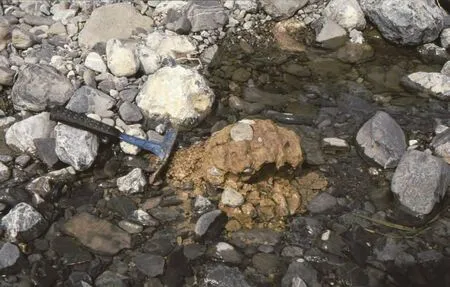
Figure 7 Armoured mud ball crumbling in water.
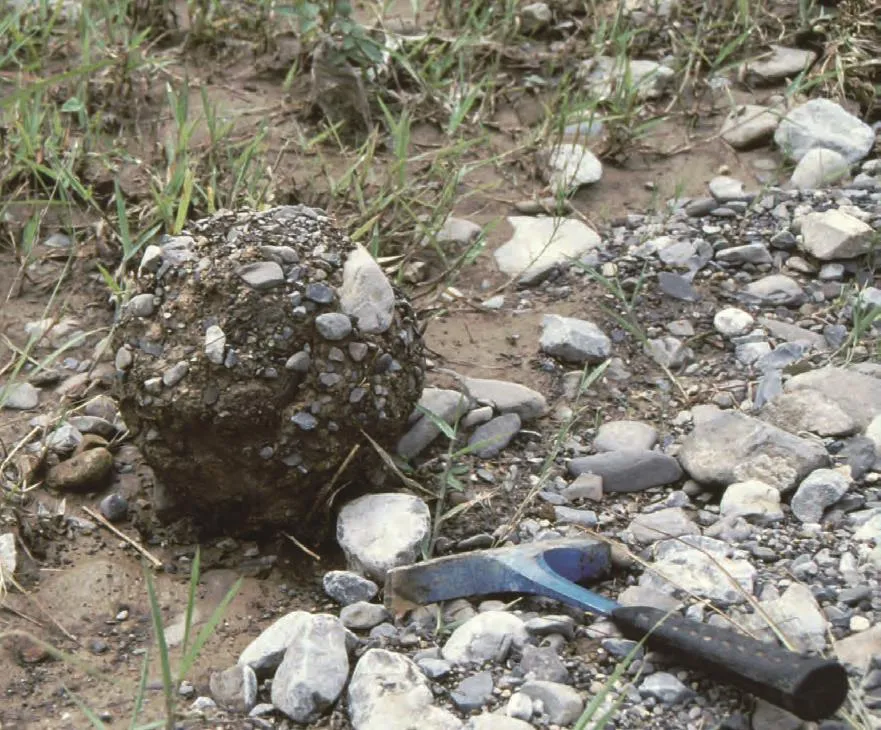
Figure 8 Unusually large armoured mud ball, with a diameter of 15 cm.
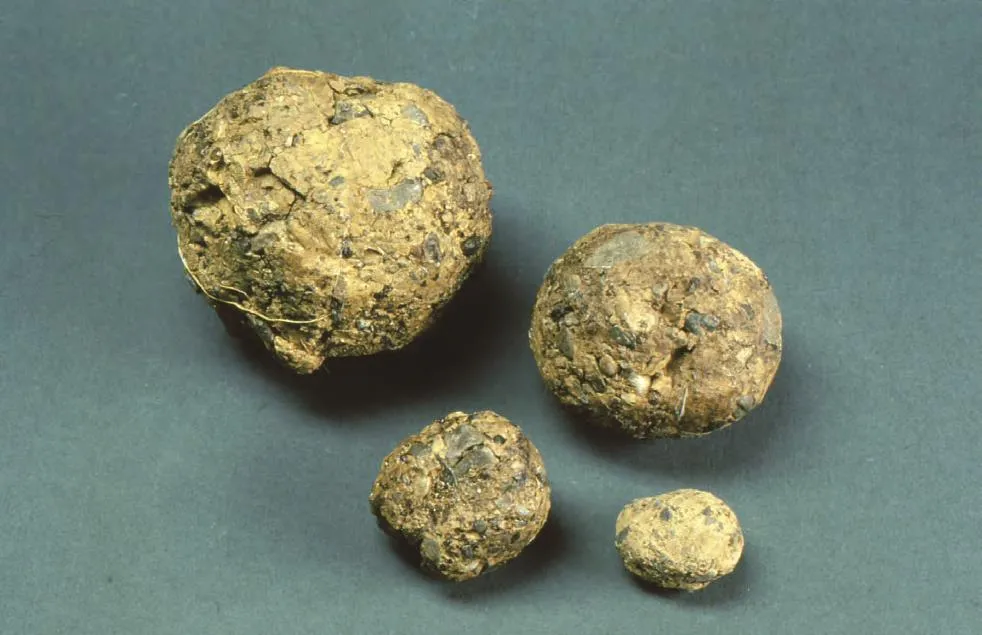
Figure 9 Armoured mud pebbles of different size, the largest is 6 cm in diameter. Impregnated with resin.
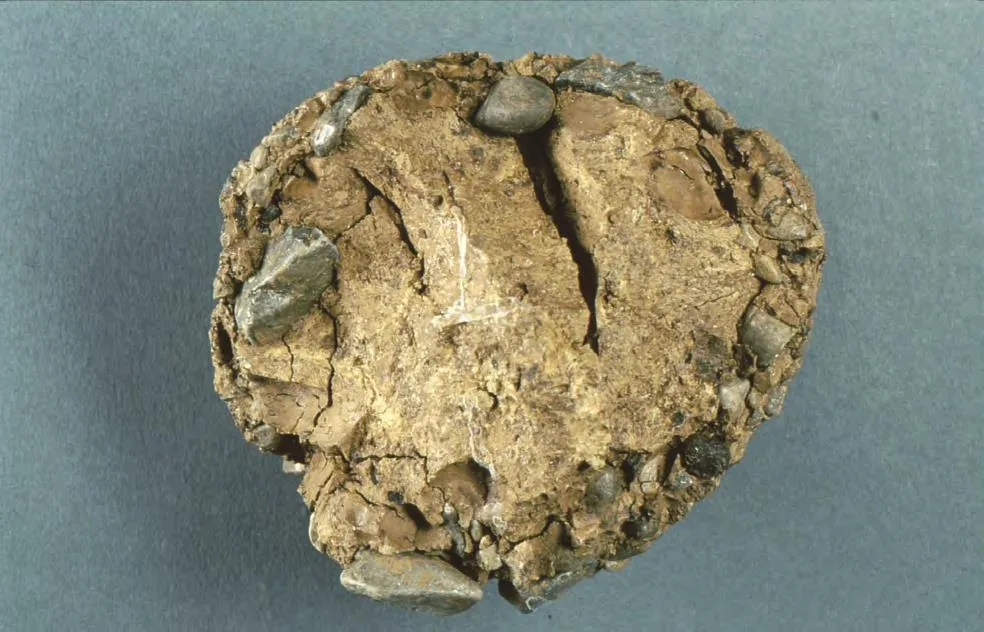
Figure 10 Armoured mud ball, intentionally broken in half, showing sand and gravel rim and desiccation cracks, with a diameter of 8 cm. Impregnated with resin.
Not surprisingly, fossil armoured mud balls have been observed less frequently than modern, primarily because of poor preservation potential, but many may also have been overlooked or mistaken. Therefore special attention should be given to ancient braided or meandering river sand or gravel deposits for armoured mud balls and their relics.
6 Conclusions
1) Armoured mud balls were found after a short flood event lying on the gravel floor of the otherwise dry Xiaohe(small river) valley, Guanling County, Guizhou Province,South China, approximately 30 km southwest of Guanling County. To the best of our knowledge this is the first description of armoured mud balls in China.
2) Armoured mud balls are most common in a semi-arid climate, but rather unusual in a humid climate such as in Guizhou Province.
3) The mud balls are well rounded, 2-20 cm in diameter, and consist of soft, but relatively stiff, light brown and slightly mottled clay without carbonate content.
4) The surfaces of the mud balls are studded with sandor gravel-size limestone clasts collected during bedload transport.
5)The origin of the mud balls is from alluvial mudstones that are most likely derived from soils of weathered karstified limestones.
6) As floods are rather frequent in the area, the formation of armoured mud balls should be common along the Xiaohe and in similar valleys nearby, giving the chance for further and more detailed studies.
Acknowledgements
The author is much indebted to Prof. Dr. Xiao-Feng Wang of the former Yichang Institute of Geology and Mineral Resources, China Geological Survey (now Wuhan Institute of Geology and Mineral Resources, CGS), for organizing and generously supporting the Guanling Fauna Project (Wanget al.,2006, 2008), during which the described armoured mud balls were observed. Prof. Dr. Dr.h. c. Mult. Gerald M. Friedman, Troy, New York, USA, is thanked for providing additional information on armoured mud balls. Dr. M. Franz, Freiberg/Sachsen is acknowledged for helpful criticism of the manuscript and Prof.Dr. I. Lerche, Halle/Saale for improving the English text.The careful reviews of Profs. Zeng-Zhao Feng and Ming-Xiang Mei, both from Beijing, and the editing of Ms. Yuan Wang, Beijing, are gratefully acknowledged.
 Journal of Palaeogeography2014年4期
Journal of Palaeogeography2014年4期
- Journal of Palaeogeography的其它文章
- Lithofacies palaeogeography of the Late Permian Wujiaping Age in the Middle and Upper Yangtze Region, China
- Reply to Shanmugam, G.“Review of research in internal-wave and internal-tide deposits of China:Discussion”
- Review of molar tooth structure research
- Review of research in internal-wave and internal-tide deposits of China: Discussion
- Reply to Shanmugam, G. “Review of research in internal-wave and internal-tide deposits of China:Discussion”
- Summary of the Editorial Committee Meeting of Journal of Palaeogeography in Geneva, at the 19th International Sedimentological Congress (ISC)
